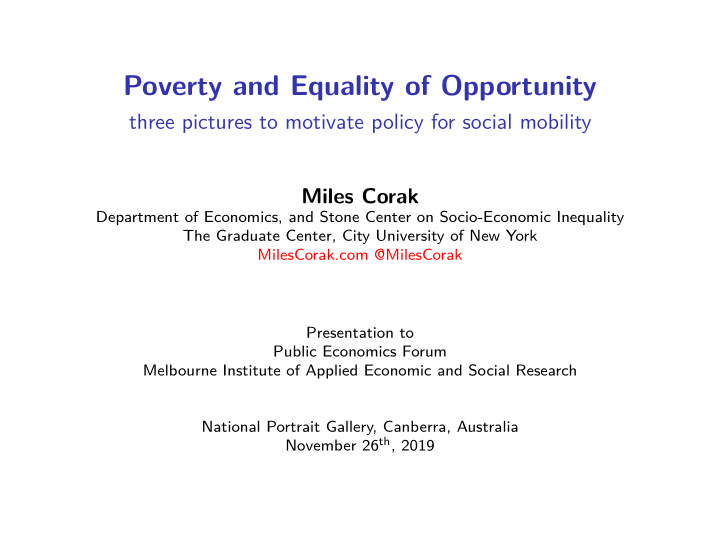



Poverty and Equality of Opportunity three pictures to motivate policy for social mobility Miles Corak Department of Economics, and Stone Center on Socio-Economic Inequality The Graduate Center, City University of New York MilesCorak.com @MilesCorak Presentation to Public Economics Forum Melbourne Institute of Applied Economic and Social Research National Portrait Gallery, Canberra, Australia November 26 th , 2019
1. Social mobility varies across countries incomes are stickier across generations where inequality is higher USA Fraction of inequality passed on to the next generation (%) ITA 50 MEX GBR ESP 40 KOR LUX FRA JPN GRC SVN NLD 30 NZL CAN PRT AUS SWE CHE IRL AUT DEU 20 NOR BEL DNK FIN 10 20 25 30 35 40 Higher Inequality (disposable income Gini in parent's generation)
2. Bottom half income inequality drives social mobility OECD child poverty rates average 13%, but vary significantly Turkey 25.3 Fourteen Israel 23.2 countries Spain 22.1 had child Chile 21.1 poverty United States 19.9 rates Mexico 19.7 above the Italy 19.3 OECD Greece 18.9 average Canada 17.1 in 2015, Japan including 16.3 Canada. Portugal 15.5 Slovak Republic 14.8 New Zealand 14.1 Poland 13.4 Australia 13 Latvia Twenty−one 12.2 countries Estonia 12.1 had child 11.8 Hungary poverty 11.3 Luxembourg rates 11.3 France below the United Kingdom 11.2 OECD Belgium 11 average Czech Republic 10.5 in 2015, 10.2 Netherlands with 9.9 Switzerland Finland 9.6 Austria and Denmark Germany about 10 9.5 Ireland percentage 9.2 Sweden points 9.1 lower. 7.3 Norway 7.2 Iceland 7.1 Korea Slovenia 7 Finland 3.7 Denmark 2.9 −10 −5 13.1 % +5 +10 percentage points below average percentage points above average
3. Canada’s poverty reduction strategy has three elements the first sets targets to monitor progress Canada's official rate of income poverty has fallen below one−in−ten for the first time, going below the interim target During 2015 the Rate of Income Poverty was 12.1% just below the and in 2017 it fell to 9.5% 2020 target of 10% set in Canada's Poverty Reduction Strategy but still a way to go before reaching the 2030 target of 6% Source: MilesCorak.com using Statistics Canada data on the Market Basket Measure 2000 2005 2010 2015 2020 2025 2030
3. Canada’s poverty reduction strategy has three elements 1. An official poverty line and targets ◮ sets an official poverty line and establishes targets for poverty reduction 2. Supporting indicators ◮ conditions the nature of the reduction with three sets of supporting indicators 3. A “contract” with future governments ◮ embeds poverty reduction into the longer term horizon for successive governments
Miles Corak @MilesCorak
Figure 1: Official poverty indicator
Figure 2: Supporting indicators: Dignity and basic needs.
Figure 3: Supporting indicators: Opportunity and inclusion.
Figure 4: Supporting indicators: Resilience and security.
Recommend
More recommend